Future homeschooling mother
Comments are off
Comments are off
The recommendations in this post also appear on my Brave Writer Retreat Resources page, which includes books and materials mentioned in my other talks at the Retreat (Tidal Homeschooling and Read-Alouds).
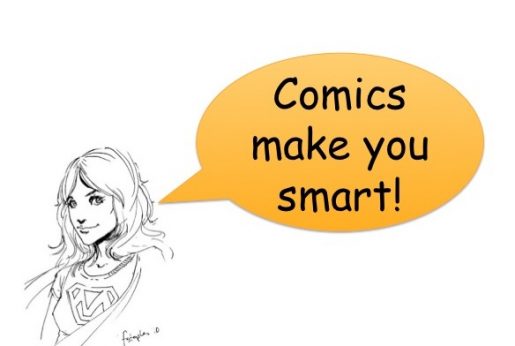
Part of this talk was broadcast on Periscope—you can view it here. Note: For now, what follows is simply a booklist—no mini-reviews. I’ll add those as time permits. I promised the retreat attendees I’d put together a post of all the comics I mentioned in my talk, so here it is for easy reference. Commentary to come later!
Gotham Adventures by Scott Peterson (my brilliant hubby)—Batman comics aimed at young readers. These came out monthly in the ’90s and are now available in digital editions. (The books at this link that say “by Ty Templeton” were edited by Scott; the others were written by him.)
Me: Check out paragraph 2 of this press release I just got—
May 5, 2016, Mount Laurel, NJ: Four of the leading independent comic book publishers have come together with Groupees to offer fans a low cost entry into the world of original storytelling from some of the leading names in graphic fiction!
This cross-publisher pay what you want “Bundle of Independents” features approximately $300 worth of books by some of the industry’s greatest creators from Garth Ennis, Greg Rucka, Duane Swierczynski, Andy Diggle, Howard Chaykin, Peter Milligan, Andy Diggle, Jim Starlin, Jae Lee, Joshua Hale Fialkov, Tim Seeley, Jeff Lemire, Dustin Nguyen, Brian Wood, Rick Remender, Joe Hill, Sam Keith, Charles Soule, Cullen Bunn, and more!
brilliant editing, guys
Scott: that’s so embarrassing
Me: ALSO
The all-men lineup. Lower in the press release you learn that one of the items in the bundle is Saga.
Why on earth wouldn’t you mention Fiona (and BKV for that matter) in your summary???
Scott: that’s insane.
But you know what? They didn’t mention Darwyn Cooke, either. Or Bryan Lee O’Malley, Walter Simonson.
Poorly done
Me:

Scott: what a perfect expression
Me: He’s the Mr. Knightley to the Emma actress you looked up the other day, the one I knew SO WELL
from, you know, Emma
Scott: yes
He’s Sherlock
Me: Also Edmund from Mansfield Park
Scott: yes
Me: You realize this is why nothing gets done in modern civilization
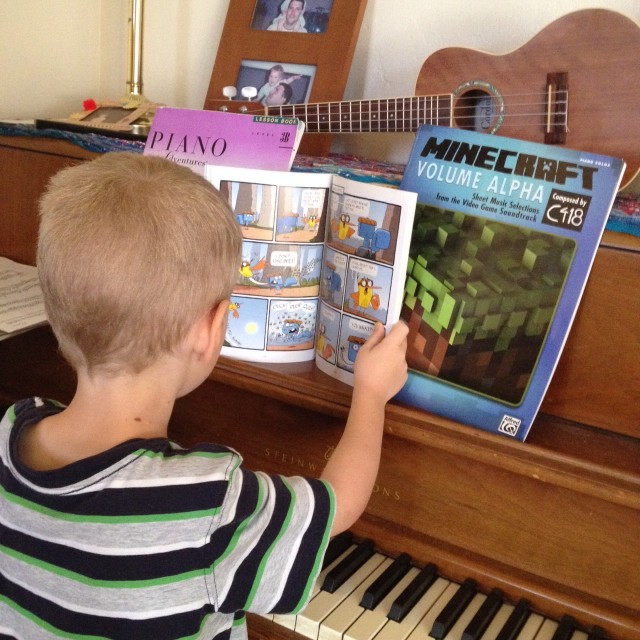
Reading a Bird and Squirrel book by James Burks
I chimed in on a discussion on my local homeschooling list about one mom’s concerns that her son had stalled on the learning-to-read process. As usual I found I had a lot to say, so I’m scooping it here (and expanding a bit) in case it’s of interest to others.
I’ll second what E. said: Six is really very young and at this point (and every point, really), the VERY BEST thing you can do is to read aloud a great deal. There are lots of studies to back up what many of us have been discovering and advocating for years about the immense and rather extraordinary benefits of reading aloud.
• We always turn on the captions when our children watch TV. And it’s amazing how much reading they can pick up from scrolling through the DVR. Huck could distinguish between “Little Bear” and “Little Bill” at age three—his first sight words.
• Video games! or apps, etc. My kids have all picked up a lot of reading just from encountering the repeated text instructions and captioning that is a part of many games.
• Comics and graphic novels. Great reinforcement of decoding skills and incentive to read. Plus, you know, FUN. My 3rd child learned to read from Tintin Comics. Her older sisters read them and she pored over the pictures until she began to pick up words. (I read them to her whenever she asked but that stage didn’t last long–she just loved to explore them them on her own!) (I’ve written more about this here.)
• Word games and puns. We are a wordy, wordy family. Dinner-table conversation will often involve why a thing is called what it’s called–what the root word is, where it came from. Someone will hop up to look up a word origin. And scarcely a day passes without some terrible, groan-inducing pun trotting around the house. When I teach kids’ writing and lit classes (I’m teaching three different groups of kids at present), I begin every class by soliciting contributions to our ‘Word Hoard’—asking the kids to look out for interesting words during the week to add to our collection. They really get into the spirit of the game and we have amassed some splendid word piles over the weeks. The boys in my Friday afternoon class have turned it into a competition of sorts, unfurling mile-long words to impress their classmates. I’ve learned a lot of obscure medical terms in the past month, let me tell you.
• Riddles, jokes, joke books!
I am not a fan of 100 Easy Lessons because of so many similar stories of kids getting turned off to reading, or stressed/intimidated/bored–
Books of facts are great for young kids–early reader science stuff, etc. Again, lots of pictures to draw them in & help with decoding.
The process can be more organic, less structured. Help them along the way you helped and encouraged them to learn to talk. Read together, allowing lots of conversation and lingering and interruptions to hyperfocus on some little piece of a picture.* Chat about street signs, store names, food labels (kids will pick those up as sight words very quickly and naturally). Text is all over our world, not just in books, and reading doesn’t have to be a Capital R academic exercise. People naturally want to find things out, and reading becomes a means of doing that–so sooner or later, every child will have an interest that drives literacy. What you can do is support that interest. Feed it! Rustle up some intriguing-looking books on the topic, preferably ones with a lot of art.
(Here I come back to video games: one of my girls got so interested in a certain game that she wanted to look up guides for it online, and HER reading took a huge leap forward as she began to devour information about this game. My role was to help her safely find resources on the internet, print out useful pages, provide supplies for assembling a binder (her idea)…so you can see there are many ways for a parent to be involved in the process, guiding, facilitating, without it looking like formal reading instruction–an activity that is so stressful for many children. Lots of so-called ‘reluctant readers’ will inhale anything you give them that’s about their favorite video game. Let them hunt for cheat sites. Who cares if they don’t figure out a game level on their own? They are learning crucial research skills–how to frame questions and find answers, and how to apply that information to a practical task. Hurrah for game cheats!)
Current example: Huck is obsessed with Rose’s Snap Circuits set. This morning I stood in the living room for the longest time, watching him—his back was to me—deeply absorbed in assembling one of the projects in the guidebook. He has worked his way through the entire project book with minimal help, following the picture instructions but also puzzling out chunks of text. Sometimes he asks for help with a mouthful word like “capacitor”—no self-consciousness, no sense that he is young to be expecting to be able to read a word like that. He can’t figure it out, he asks for help. But poring over this book, casually encountering these giant words that tell him things he wants to know, has catapulted his reading skills forward in a way no teacher, no matter how good, how patient, could reproduce. If I made him sit down to a reading curriculum, I can guarantee he would be restless and fretful within minutes. But he’ll spend the whole afternoon immersed in building projects out of this book, interacting with the pictures and text, following complex directions—and consider it ‘playing.’ As in, “Can I play with your Snap Circuits again today?” he’ll beg his big sister.
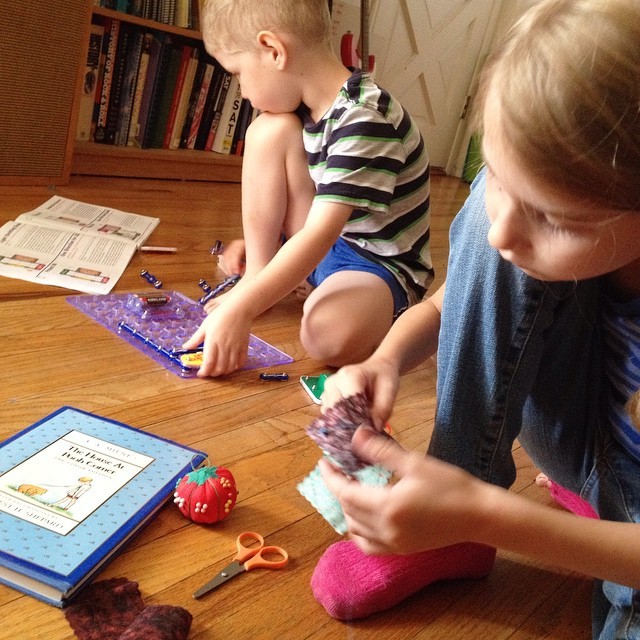
*********
*Let me elaborate on what I said above about “allowing lots of conversation and lingering and interruptions to hyperfocus on some little piece of a picture.” A lot of adults have difficulty tolerating interruptions during a readaloud. There’s a whole big conversation to be had about how much background activity to allow — like, Legos keep little hands busy but can be very noisy. There are ways to work around that (spread out Legos on the floor before reading, since the noisiest part is the digging through the bin–things like that). But what I want to focus on right now are the interruptions that come when a child is looking at the book with you and starts talking over the narrative–pointing at things in the art, or otherwise being chatty about the book instead of listening to the story. This activity may actually be an indication of a big leap forward in skill acquisition–but we adults don’t always see it that way!
Here’s an example — when Rose was five or six, I remember reading her My Father’s Dragon. She was right at the point of emergent literacy, beginning to recognize words like street signs and store names as I mentioned above. We were about halfway through this short novel as a read-aloud when she started pointing out Elmer’s name on every page. And “the dragon” and “the cat” — words repeated often in the story. But mainly it was the word “Elmer” (the main character). It got to where I couldn’t get through a page, because she kept pointing at the name all over the place. And I had a moment of being irritated and wanting to hush her–now now, let’s listen to the story. But it hit me in a flash that what we were doing together — what SHE was experiencing in this moment — had changed. It had started out “listening to a story.” Now it was READING. She had learned a sight word and was putting this new skill to use, with numerous opportunities to “practice” it on every page. No curriculum in the world could top this skill practice, because it was completely voluntary and completely absorbing her. It was HER activity, not one imposed upon her from the outside.
So, in that hour snuggled beside her on her bed, I let go of the whole listen-to-this-story concept. I kept on reading to her, page after page, but that was merely a background activity providing the vehicle for her discovery. “Elmer…Elmer…the dragon…” — little finger pointing, skipping around the page. We finished the book that way, with Rose only half paying attention to the words I was reading. When I got to the end, she said it was the best book ever and asked me to start it over. The second time through, she listened raptly to the narrative. 🙂 Her brain had finished its self-assigned task. By the time I finished the book for the second time (a week or two later), she was reading very well on her own.
So that’s what I mean about stepping back to reassess an activity and your objectives….if a child is focusing on some part of the story that isn’t your voice reading the words, there is probably a very good reason. A wonderful thing about homeschooling is we have the luxury of time and space to allow this process to unfold at the child’s pace–there is no pressure to ‘get through’ a certain amount of material by a set date.
Remember that time Rilla thought the phrase “into the thick of it” was “into the thicklebit”? And I loved it so much I threatened to rename this blog after it? Well, we’ve decided to go one better. Voila…Into the Thicklebit, a webcomic cowritten by Scott and me, and illustrated by the impossibly brilliant Chris Gugliotti. We hope you’ll enjoy it. You may recognize some Bonny Glen moments here and there. (Hair color has been changed to protect the obstreperous.) 😉
I’ll add a button to the sidebar after SDCC madness is over. We’re aiming for new strips twice a week, when time permits. Tomorrow’s is one of my favorites. (And 100% true.)
December already! Impossible.
I’ve been trying to catch up my GoodReads log, but with all these graphic novels I’m reading for Cybils, it’s hard to keep it up to date. November’s list is too long to recreate here, but I’ll call out a few of my favorite reads from the month.
(Links go to GoodReads.)
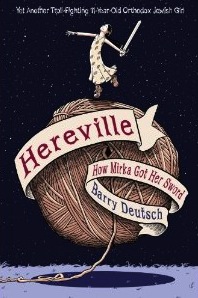 Hereville: How Mirka Got Her Sword by Barry Deutsch.
Hereville: How Mirka Got Her Sword by Barry Deutsch.I keep calling this Trollville by accident because of the (perfectly delicious) subtitle: “Yet another troll-fighting 11-year-old Orthodox Jewish girl.” Middle-grade graphic novel published by Amulet Books. Enchanted Beanie and me. Mirka wants to fight monsters but gets entangled with a foul-tempered talking pig instead. Her sometimes comical, often hair-raising adventures occur in the context of a full, tradition-centered home life. I love books that mingle the small, gritty challenges of daily life with grand, fantastic adventures—but maybe you already knew that about me?
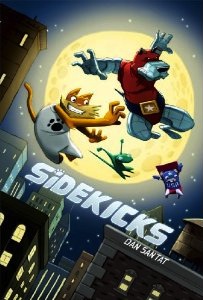 Sidekicks by Dan Santat.
Sidekicks by Dan Santat.This is the gift to give your 8-12-year-old nephew or niece if you want the Coolest Uncle Ever award. Or Coolest Aunt. Whichever. An aging superhero announces that he is holding auditions for a new sidekick. His pets, who miss his company, decide to try out. His pets? Are a dog, a hamster, and a lizard. That’s right. The hamster is trying out for the superhero sidekick gig. It’s equal parts heartwarming and hilarious. And the art just knocked—my—socks—off.
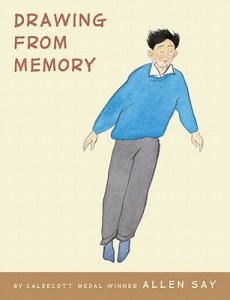 Drawing from Memory by Allen Say.
Drawing from Memory by Allen Say.This book is really special. It’s a memoir in words and pictures. Allen Say recounts the story of his life with poignant candor. At age twelve, he goes to Tokyo to live alone (!) in order to attend a good school. His tiny one-room apartment has everything young Allen needs: solitude and a desk he can draw at. In a move full of gumption, he approaches a renowned cartoonist and asks to train under him. Amazing story. Beanie’s read it at least three times now.
I read some other excellent books this month and maybe I’ll do a part two of this post, but the days do roll away from me.
The other day I was sharing some thoughts on Twitter about storytelling and layout problems I see in many (but by no means ALL) of the graphic novels coming out of book publishing houses lately, and Raina Telgemeier (Smile) chimed in with a link to an essay that had a profound affect on her development as an artist. Here’s our conversation, with the essay link at the bottom. The essay is called “How to Read Nancy” by Mark Newgarden and Paul Karasik, and it’s fascinating. The authors take a close, critical look at the old Nancy comic strip by Ernie Bushmiller. Yes, really! It’s some of the best analysis of visual design principles I’ve ever read.
Me:
Dear book publishers branching into graphic novels: Thrilled, but your ballooning & storytelling mistakes are KILLING me.
@ryancecil asked:
Wouldn’t that be the author/artist’s mistake first?
Me:
Yes but it’s the editor’s job to hire good pencillers, correct clumsy storytelling.
First Second, Random House, Scholastic are doing graphic novels well. Sometimes lettering/ballooning could be better but hey, so could Big 2’s [Marvel & DC]
I’m talking about readability here, not plot. Visual storytelling, ballooning, lettering. Layouts, camera angles, the way a page flows.
Am seeing books from other publishers which make what seem to me rookie mistakes. Confusing layouts & ballooning, stacking panels on left, etc.
Just reading your thoughts on GNs. I agree, confusing balloon/panel layout is a real problem! Especially for kids’ books.
Me:
Yes, in kids’ graphic novels, good ballooning/layout even more important. Should lead eye, not perplex. YOUR layouts rock, btw!
Have read several dozen kids’/YA graphic novels for Cybils this month, dozens to go by end of year. At least 1/2 make panel layout mistakes.
I think many GN artists are following film storytelling technique rather than good comics technique. Also too much fancy lettering.
I’m seeing some stellar graphic novels this year, mind you. Some that make you feel lucky to be alive & reading in 2011.
When I’m laying out pages, I start with the panels/boxes. Lettering & balloons come next—before the drawings!
Mark Newgarden wrote a terrific article called How To Read Nancy with the bare bones of comics principles… http://t.co/rflMWCFF [link opens a PDF]
I read it as a teenager and have applied the logic to my work ever since.
Specifically, how to lead the reader’s eye thru a comic, to arrive at the punchline/end of the page exactly as artist intends.
This explains a lot about why Raina’s work is so terrific.
(I am champing at the bit for her upcoming middle-grade graphic novel, Drama, about a school drama club, aka MY PEOPLE.)
P.S. Raina is the only other person I know whose husband proposed to her in a comic book. Read it and melt. 🙂
A friend pointed me toward a conversation in which a 6th-grade teacher explains why he “reflexively cringe[s]” when he sees his students head for the comics and graphic novel section of the school library. His first post, which suggests that graphic novels are “nothing more than the literary equivalent of Jersey Shore for our kids,” drew an impassioned response from comics advocates. (The entire comment thread is worth reading.) In his follow-up post, the blogger acknowledges that he is, as a result of the discussion, reevaluating his stance on graphic novels, but he’s still not entirely convinced of their merits—not without informed guidance from a teacher, that is.
Just like iPads, graphic novels AREN’T magical tools. One of the things that blows my mind is the blind faith that many people seem to put in the ability of graphic novels to save struggling readers.
My favorite comment of this entire conversation came in my email inbox from a teacher who described graphic novels as a “fanciful dance” that:
- Encouraged visual literacy skills.
- Taught students to interpret and analyze at a deep and meaningful level.
- Introduced students to video production skills.
- Engaged readers in critical self-analysis.
Listen to those words, y’all: encouraged, taught, introduced and engaged. Books don’t do those things.
Teachers do.
(His post continues here.)
I chimed in with this response:
Teachers *may* do those things, but books certainly can and do “encourage, teach, introduce, and engage.” I’m sure you could find examples in your own life, both as a kid and an adult, when you learned something from a book without the intercession of a teacher. I can certainly point to many examples in my own life and my kids’ lives.
Here’s one: I bought a book on weaving and learned to weave by following the instructions in the book. I made hand towels and scarves without ever speaking to a weaving teacher or expert. The book taught me how.
I have certainly been “engaged” by hundreds upon hundreds of books.
A quick list of topics to which I was “introduced” by a book would include beekeeping, westward expansion, political strife in Burma, candymaking, English gardening, Greek mythology, the Salem witch trials, and–this list could go on for days! I’m sure your own list would be a mile long. 🙂
Raina Telgemeier’s excellent middle-grade graphic novel, SMILE, has proved a source of great encouragement to my 12yo daughter as she copes with orthodontic work. SMILE, incidentally, is an example of a smart, literary graphic novel that engages readers and gets them excited about reading, sending them hunting for more great books.
Another of my children made a huge leap in reading fluency and comprehension at age six when she jumped from the Bob books (beginning reader series) to Tintin comics. Her older sisters were Tintin fans, and the 6yo would pore over the pictures and puzzle out the words, wanting to read just like the big girls. The art is what drew her in, but she desperately wanted to know what was going on in those word balloons. The vocabulary, as is often the case in graphic novels and comics, was quite sophisticated. The stories introduced her (to borrow your word) to countries and cultures all over the world. At the time, I was reading aloud to her from various children’s novels, but she read Tintin by herself, asking for help only occasionally. That child is now 10 years old and an avid reader–of prose and comics. Her favorite authors are Roald Dahl, Emily Rodda, and Brian Jacques–all prose novelists.
I know this is but one anecdotal example of a kid whose door to reading was a comic book. I have heard many, many similar stories. At the recent San Diego Comic-Con, I attended a panel on Comics in the Library in which four public librarians talked about (among other things) the ways they see kids reading and learning from comics. I was particularly struck by a comment from one of the panelists, who said he read comics almost exclusively as a kid–and went on to major in English, get his MLS, and become a librarian.
I’m glad you’re reassessing your thoughts on graphic novels—the Jersey Shore comparison was seriously off base—but it seems like you’re caught on the notion that books require teachers as intermediaries, and that too seems off base and contrary to the experience of, well, millions of kids and adults who have learned incredible things alone with a book.
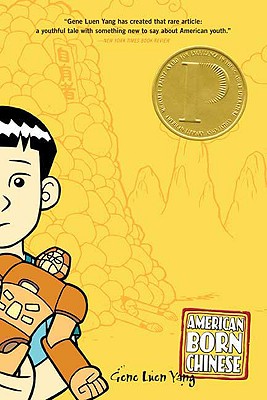 No response yet, but I appreciate that he’s been open to the discussion with the commenters on his blog, and I hope he’ll read some of the excellent books they have recommended, including one of my own favorites, Gene Yang’s American Born Chinese—a rather brilliant and deeply moving graphic novel about a Chinese-American boy struggling with identity and acceptance. I think this teacher’s negative feelings about comics are quite common among adults, especially those who sincerely wish to cultivate in students a love for reading and a nuanced engagement with literature. Comics may strike these adults as fluff, twaddle, mental junk food. In my experience, this negative stance nearly always means the adult hasn’t read many comics—or is possibly repeating disparaging things said by adults in his life when he was a kid immersed in the exploits of Metamorpho and Adam Strange, so enchanted by story and pictures that he didn’t notice he was acquiring an impressive vocabulary and a sophisticated grasp of story structure, character development, and setting.
No response yet, but I appreciate that he’s been open to the discussion with the commenters on his blog, and I hope he’ll read some of the excellent books they have recommended, including one of my own favorites, Gene Yang’s American Born Chinese—a rather brilliant and deeply moving graphic novel about a Chinese-American boy struggling with identity and acceptance. I think this teacher’s negative feelings about comics are quite common among adults, especially those who sincerely wish to cultivate in students a love for reading and a nuanced engagement with literature. Comics may strike these adults as fluff, twaddle, mental junk food. In my experience, this negative stance nearly always means the adult hasn’t read many comics—or is possibly repeating disparaging things said by adults in his life when he was a kid immersed in the exploits of Metamorpho and Adam Strange, so enchanted by story and pictures that he didn’t notice he was acquiring an impressive vocabulary and a sophisticated grasp of story structure, character development, and setting.
Amusing side note: today’s mail brought a review copy of The Manga Guide to the Universe by No Starch Press. Jane has learned a ton about electricity, relativity, and statistics from previous Manga Guides. I would be so much smarter if I read more comics…
My favorite costume: Neo-Victorian biologist (at GeekMom)
Day 2: Again with the Quick Peeks
Things My Kids Can’t Wait to See at SDCC (at GeekMom)
The Streets of San Diego (at GeekMom)
SDCC Teen Comics Workshop (at GeekMom)—emphasis on art
SDCC Comics for Teens Recap (at GeekMom)—emphasis on writing